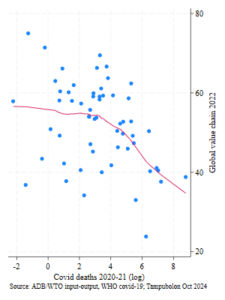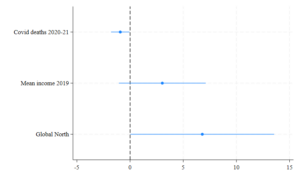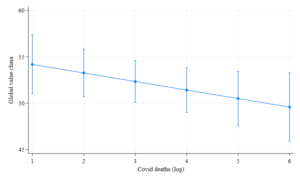by Dr Gindo Tampubolon, Reader in Global Health
The COVID-19 pandemic forced countries to make difficult choices between protecting lives and supporting livelihoods, including jobs in global value chains (GVCs). While some countries reinforced onshore manufacturing capacity for essential goods, others reconfigured their participation in GVCs – the complex networks that have delivered the fruits of globalisation. Beyond policy choices, did the pandemic’s toll of 14 million excess deaths leave a lasting imprint on GVCs?
This is not a foregone conclusion. People adapted to new ways of working, shifting to remote operations where possible. Firms deployed advanced technologies in production. The world response has even cemented new technologies including mRNA technology for vaccines and drugs with Nobel prizes and biotech startups. Yet the empirical evidence tells a sobering story.
Materials
I draw from two key sources: the WHO excess death dataset and the Asian Development Bank’s newly released multi-region input-output table, covering 63 countries across 53 economic sectors. This input-output approach follows the framework established in flagship reports by the World Bank (2020) and the World Trade Organisation-Asian Development Bank (2023), building on Borin and Mancini’s (2015) computational framework I used in a blog on GVCs post-Brexit.
The outcome of interest is GVC participation – measured as the total of backward and forward value added as a share of exports. To capture pandemic management ability, I include average incomes, reflecting capacity to weather such shocks, as well as the North-South divide, reflecting vaccine hoarding during the early response to the pandemic.
GVC research can be approached from a firms-and-products perspective, using case studies, and from an economy-and-sector perspective, drawing from macroeconomic accounts, trade numbers and intercountry input-output tables. Today, the ADB database is the only database with input-output table from the post-pandemic period. The World Bank flagship report and the joint WTO-ADB flagship report predominantly used the second perspective, making heavy use of the input output tables to derive GVC statistics. I follow suit.
I advance a labour losses hypothesis which suggests that countries losing more people during the pandemic are more likely to reduce their participation in GVCs subsequently because labour is counted among the losses.
Results
Having assembled the ADB/WTO/WHO dataset, I then explore the relationship in a graph. This graph shows an interesting association between COVID-19 excess deaths in 2020-2021 and GVC participation in 2022 across different countries, revealing important patterns.
There is a clear negative relationship, especially pronounced at high excess deaths. The red line or smoothed fit shows this relationship is relatively flat initially, but drops more steeply as COVID-19 deaths increase. The country dots show considerable spread, suggesting that other factors are also at play.
Countries that experienced higher COVID -19 death rates tend to show lower participation in GVCs in the following year, and this relationship becomes particularly pronounced beyond a certain threshold. Altogether this suggests that severe COVID-19 impacts may have led to longer-term disruption in countries’ ability to participate in GVCs – an enduring economic impact of the pandemic on international trade participation. The pattern could reflect both direct impacts (reconfiguration during the pandemic) and longer-term structural changes.
Figure 1. Excess deaths during COVID-19 pandemic (log) and post-pandemic GVC participation as share in export (N=59 countries). Source: WHO and ADB/WTO.
I further explored whether this impact is significant, given other factors such as economic levels (income per person) and North-South divide (reflecting hoarding of vaccines in the pandemic response). The small sample precludes extensive investigation.
Figure 2. Coefficients plot explaining post-pandemic GVC participation in terms of earlier COVID-19 excess deaths, average incomes and North-South divide (N=59).
Post-pandemic GVC participation is associated with and significantly followed the earlier pandemic excess deaths (Figure 2, top row). Consistent with the hypothesis of labour losses, higher excess death rate is followed by reduced participation in GVCs. The global north (in contrast to the global south) was significantly more engaged in GVCs as early as 2022. The bivariate pattern in Figure 1 remains important, excess deaths during the pandemic is followed by reduced GVC participation.
To focus on the key factor of COVID-19 excess death, I draw its marginal plot as death increased from a handful to one million lives (four countries belong to this unenviable club: Indonesia, US, India and Russia). Through the span of excess death numbers, the difference in GVC participation is twelve percent. The number of excess deaths, with its follow up in reduced GVC participation, is not mere statistical artefact – the magnitude is considerable.
Figure 3. Marginal predictions of post-pandemic GVC participation as COVID-19 excess deaths increase.
The total value added created by the four countries in 2022 is $28.8trillion (ADB/WTO 2023). All else equal, this number is only 88 percent of what the world could have gained post-pandemic. This magnitude suggests that this labour loss impact on global value chain participation deserves further investigation. Equally clear is causal inference cannot take the method of randomised trials with the vicious SARS-Cov-2.
This relationship adds another chapter to the pandemic’s ongoing story – one where excess deaths cast long shadows on global economic integration. While technology and adaptation provided some resilience, the data suggests that losing millions of workers who operated the stations of global production has left a measurable gap in the fabric of global trade.
Note: This article gives the views of the author/academic featured and does not represent the views of the Global Development Institute as a whole.
Please feel free to use this post under the following Creative Commons license: Attribution-NonCommercial-NoDerivatives 4.0 International (CC BY-NC-ND 4.0). Full information is available here.
Photo by Sardar Faizan on Unsplash




